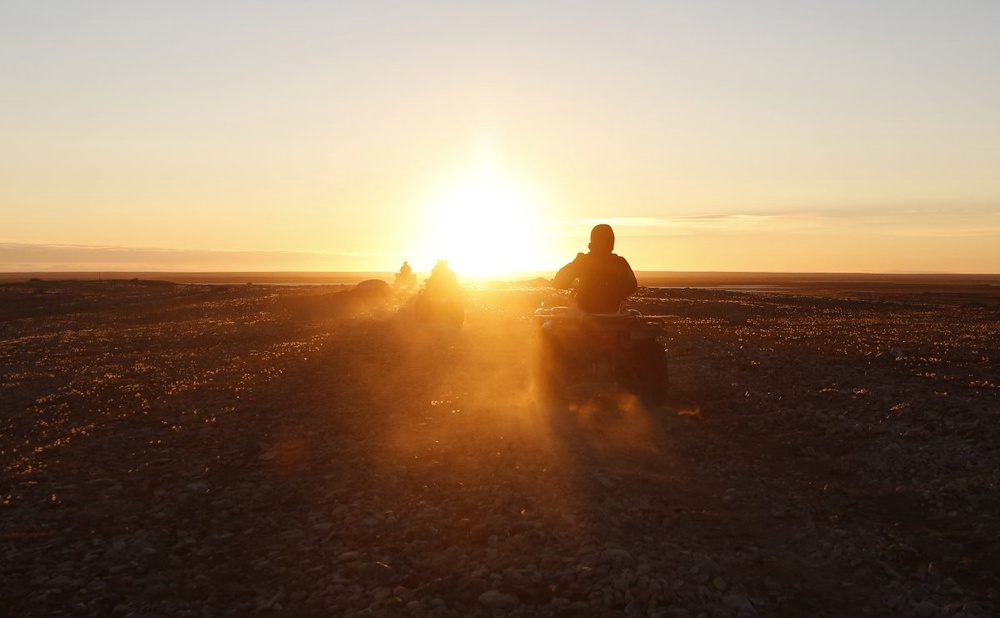
As desertification creeps into parts of the world, a rare stretch of sand in Canada's vast western plains is oddly doing the reverse -- slowly sprouting with vegetation, AFP reports. Tufts of prairie grasses are emerging throughout Spirit Sands, a stretch of dunes steeped in local lore in a popular nature park in Manitoba province. The sands cover only about four square kilometres (1.54 square miles) and in some parts, entire mounds have been completely overgrown. Today, this small patch is the only desert in Manitoba and one of only a handful in all of Canada. Once vastly bigger, it fanned out an estimated 6,500 square kilometers (2,500 square miles) -- about one-fifth the size of Belgium -- from the mouth of the Assiniboine River. Located in Spruce Woods park west of the provincial capital Winnipeg, the dunes are the last vestige of an ancient river delta, exposed 12,000 years ago when a glacier melted northward and a massive prehistoric lake drained to the south. "What we're seeing out there right now is part of natural succession... vegetation encroaching or moving into what used to be an open sand dunes area," said Jessica Elliott, head of conservation in the province. A study in the late 1990s found that the desert had shrunk by as much as 10-20 percent over each of the previous four decades, as vegetation encroached. Elliott points to several factors. "The climate is different (warmer) now than it has been in the past, there is more precipitation, wind speeds are lower," she said, and "we don't have ... large bison grazing in the area or large, intense wildfires moving through the area." Technically, Spirit Sands is not a true desert as it receives twice as much precipitation as a typical desert. But the dunes have religious significance for aboriginals not to mention unique and hardy creatures, including Manitoba's only species of lizard -- the northern prairie skink -- which lives where the sand meets the prairies and Spruce Woods forest. As well, they are a key attraction for tourists, who also come for the camping, hiking trails, horseback riding and river kayaking. According to park officials, 2,300 vehicles have visited since January. The province has considered a variety of measures to preserve the sand dunes, including using chemical herbicides, lighting a prairie wild fire, weeding by hand, or re-establishing a herd of bison in the park, which would also require building a fence hundreds of kilometers long to keep them from wandering away. But officials now appear resigned to let nature take its course. "Regardless how much vegetation is on or off the dunes, it's a beautiful place to be," said Elliott. "There are so many different spots to go and look at, enjoy the nature as is. It's got many attractions, so (we're) not worried about that at all."





As desertification creeps into parts of the world, a rare stretch of sand in Canada's vast western plains is oddly doing the reverse -- slowly sprouting with vegetation, AFP reports.
Tufts of prairie grasses are emerging throughout Spirit Sands, a stretch of dunes steeped in local lore in a popular nature park in Manitoba province.
The sands cover only about four square kilometres (1.54 square miles) and in some parts, entire mounds have been completely overgrown.
Today, this small patch is the only desert in Manitoba and one of only a handful in all of Canada.
Once vastly bigger, it fanned out an estimated 6,500 square kilometers (2,500 square miles) -- about one-fifth the size of Belgium -- from the mouth of the Assiniboine River.
Located in Spruce Woods park west of the provincial capital Winnipeg, the dunes are the last vestige of an ancient river delta, exposed 12,000 years ago when a glacier melted northward and a massive prehistoric lake drained to the south.
"What we're seeing out there right now is part of natural succession... vegetation encroaching or moving into what used to be an open sand dunes area," said Jessica Elliott, head of conservation in the province.
A study in the late 1990s found that the desert had shrunk by as much as 10-20 percent over each of the previous four decades, as vegetation encroached.
Elliott points to several factors.
"The climate is different (warmer) now than it has been in the past, there is more precipitation, wind speeds are lower," she said, and "we don't have ... large bison grazing in the area or large, intense wildfires moving through the area."
Technically, Spirit Sands is not a true desert as it receives twice as much precipitation as a typical desert.
But the dunes have religious significance for aboriginals not to mention unique and hardy creatures, including Manitoba's only species of lizard -- the northern prairie skink -- which lives where the sand meets the prairies and Spruce Woods forest.
As well, they are a key attraction for tourists, who also come for the camping, hiking trails, horseback riding and river kayaking. According to park officials, 2,300 vehicles have visited since January.
The province has considered a variety of measures to preserve the sand dunes, including using chemical herbicides, lighting a prairie wild fire, weeding by hand, or re-establishing a herd of bison in the park, which would also require building a fence hundreds of kilometers long to keep them from wandering away.
But officials now appear resigned to let nature take its course.
"Regardless how much vegetation is on or off the dunes, it's a beautiful place to be," said Elliott.
"There are so many different spots to go and look at, enjoy the nature as is. It's got many attractions, so (we're) not worried about that at all."

 +7 (777) 001 44 99
+7 (777) 001 44 99



 Қазақша
Қазақша Русский
Русский English
English














































